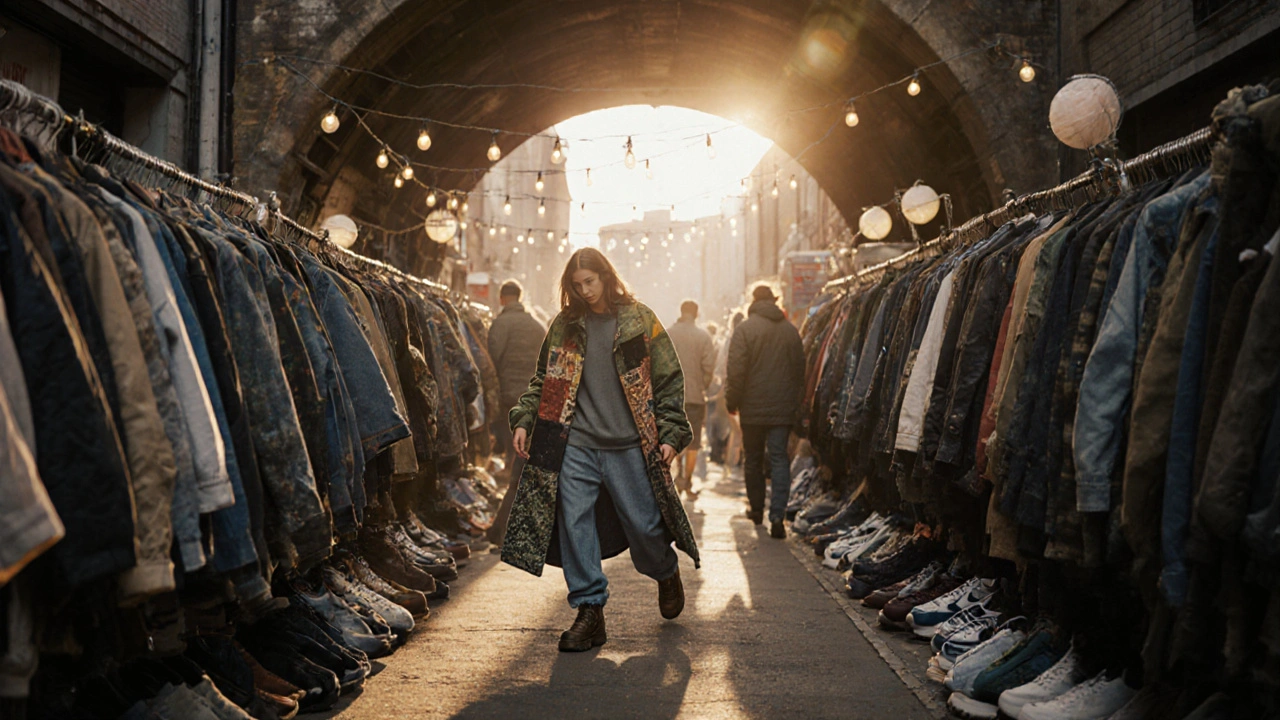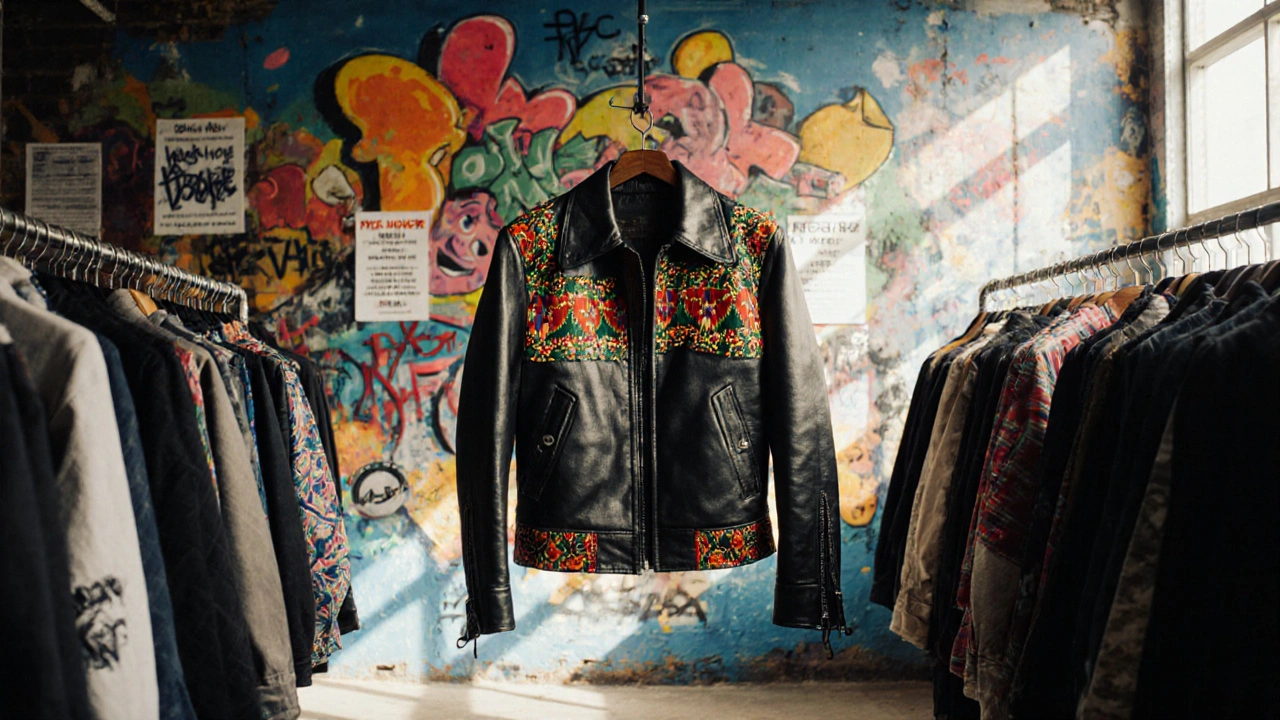
London’s street style isn’t just about what people wear-it’s about where they find it. The city’s most talked-about influencers don’t shop at big malls or online giants. They hunt down hidden boutiques, vintage markets, and independent designers tucked into backstreets and under railway arches. If you want to dress like the people who shape global trends, you need to know where they actually buy their clothes.
Brick Lane and the Vintage Goldmine
Brick Lane isn’t just a weekend brunch spot. By 10 a.m. on Saturday, the stalls are already buzzing with influencers in oversized denim and chunky boots, digging through racks of 90s Japanese denim, 80s military jackets, and deadstock Nike Air Maxes. Brick Lane is where London’s street style roots run deepest. Shops like Beyond Retro and Rokit have been around since the 90s, but it’s the smaller stalls-like London Vintage on the corner of Hanbury Street-that insiders swear by. One influencer, @londonmuse, told me she found a rare 1997 Comme des Garçons patchwork coat here for £45. It’s now worth over £800.
The secret? Go early. The best pieces go fast. And don’t just look at the tags-turn clothes inside out. Look for original labels, stitching quality, and signs of wear that tell you it’s been loved, not just stored.
Soho’s Hidden Designers
Walk down Carnaby Street and you’ll see the tourist traps. But turn down the alley between Broadwick Street and Old Compton Street, and you’ll find the real Soho. Here, tiny shops like 10 Corso Como, Stüssy London, and YMC stock limited runs from local designers who don’t do Instagram ads. YMC is a cult favorite-run by ex-Comme des Garçons staffer Mark Watson, their minimalist cuts and muted tones show up constantly on feeds from @soho_dandy and @streetstylelondon.
These aren’t big brands. They’re small teams making 50 pieces at a time. That’s why you won’t find them on Farfetch or ASOS. You have to be there. One influencer told me she waited three weeks for a restock of YMC’s cotton trench. When it dropped, she bought two. One she wore. One she sold on Vestiaire Collective for triple the price.
Peckham’s Underground Scene
Peckham used to be the place you drove through. Now it’s where the most exciting streetwear in London is born. The area around Peckham Rye Station is packed with indie shops like Wearhouse, Black Market, and House of Fine. These aren’t just stores-they’re community hubs. Many host pop-ups with local artists, DJs, and textile designers.
Wearhouse stocks pieces from emerging Black and BIPOC designers from across Europe. Their collaboration with Lagos-based label Uniqlo Lagos sold out in 48 hours. Influencers like @peckhamstyle and @africanstreetlondon post here because the clothes tell a story-about identity, migration, and rebellion. You won’t find this kind of curation in Covent Garden.

Camden’s Rebel Retail
Camden is still alive, but not in the way you think. The big chains are gone. What’s left are the rebels. Rebel Rebel on Camden High Street still sells punk boots and hand-painted leather jackets. Subculture on Hawley Road is a warehouse of 90s grunge and early 2000s rave gear. And then there’s Camden Market’s Backyard, a maze of stalls where designers sell directly to buyers.
One influencer, @camdenrebel, said she bought a pair of custom Doc Martens here for £60-hand-stitched with a hidden message inside the sole. She wore them to a fashion week party. Three brands asked to collaborate with her after the post went viral.
Notting Hill’s Quiet Luxury
If you think London street style is all logos and hype, you haven’t been to Notting Hill. Here, influencers like @nottinghillquiet and @slowstylelondon shop at Flannels for minimalist wool coats, The Row for cashmere turtlenecks, and Stella McCartney for sustainable leather. It’s not loud. It’s not flashy. But it’s everywhere.
These pieces cost more-£400 for a coat, £200 for a pair of trousers-but they last. One influencer showed me her 2019 Stella McCartney coat. She’s worn it 87 times. It still looks new. That’s the difference between fast fashion and intentional style.

The Rules of Shopping Like a London Influencer
There’s no secret formula. But there are habits.
- Don’t chase trends. Chase pieces that feel like you. One influencer told me she only buys things she can wear for at least three seasons.
- Follow local Instagram accounts, not global ones. @londonstreetstyle, @londonfashionweek, and @streetstyleuk post real finds-not paid ads.
- Visit shops on weekdays. Weekends are for tourists. Tuesday mornings are when the staff restock and you’ll get the first pick.
- Ask questions. The owners of these small shops know their stock. Ask where something came from, who made it, if there are more in the back.
- Resell what you don’t wear. Platforms like Vestiaire Collective and Depop are how London influencers fund their next buys.
What They Avoid
They don’t shop at Zara. Not because it’s bad, but because it’s everywhere. Same with H&M, Primark, and ASOS. These brands are fine for basics-but they don’t make you stand out. One influencer said, “If I see three people wearing the same Zara jacket on the tube, I change my outfit.”
They also avoid influencer collabs. The ones that say “Shop this look” with a link? Most of those are paid. The real style comes from digging, not clicking.
Where to Start
If you’re new to London’s street scene, start here:
- Brick Lane on a Saturday morning-look for vintage denim and rare sneakers.
- YMC in Soho-simple, timeless pieces with a story.
- Wearhouse in Peckham-support local designers and find something no one else has.
- Camden’s Backyard-find something bold, handmade, and one-of-a-kind.
- Flannels in Notting Hill-for investment pieces that last.
You don’t need a big budget. You need curiosity. And a willingness to walk down the wrong street.
Do London street style influencers only shop in London?
Most stick to London, but they’ll travel for specific finds. A few make annual trips to Tokyo’s Harajuku for avant-garde pieces, or Berlin’s Markthalle Neun for underground designers. But 90% of their wardrobe comes from local spots. They know the city’s hidden corners better than any tourist guide.
Can I find the same clothes online?
Sometimes-but rarely. Independent designers rarely list everything online. Even when they do, the inventory is tiny. A jacket might have only three sizes left, and the store might sell out before the post goes live. Shopping in person gives you access to the full collection, plus the chance to try things on and talk to the maker.
Are these shops expensive?
It varies. Vintage stalls in Brick Lane can be under £20. Designer pieces in Soho or Notting Hill can be £300+. But many influencers mix high and low-pairing a £15 vintage tee with a £400 coat. It’s not about spending the most. It’s about building a look that feels personal and intentional.
How do influencers afford all this?
They don’t buy everything new. Many resell pieces they no longer wear. One influencer said she makes 60% of her wardrobe budget back through Depop and Vestiaire. She also trades clothes with other influencers. A jacket she doesn’t like might go to someone else in exchange for boots she loves. It’s a circular system.
Is street style still relevant in 2025?
More than ever. Fast fashion is losing ground. People want clothes with meaning, history, and craftsmanship. London’s influencers aren’t just dressing-they’re curating cultural moments. A single photo of someone in a vintage jacket from Peckham can spark a trend across Europe. Street style isn’t dead. It’s evolved.